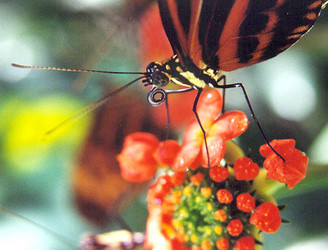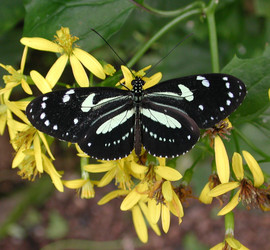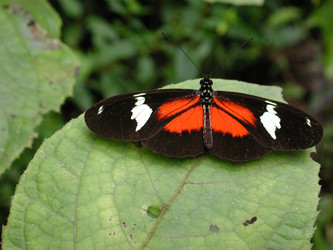Heliconius
Margarita Beltran, Andrew V. Z. Brower, and Chris Jiggins

This tree diagram shows the relationships between several groups of organisms.
The root of the current tree connects the organisms featured in this tree to their containing group and the rest of the Tree of Life. The basal branching point in the tree represents the ancestor of the other groups in the tree. This ancestor diversified over time into several descendent subgroups, which are represented as internal nodes and terminal taxa to the right.

You can click on the root to travel down the Tree of Life all the way to the root of all Life, and you can click on the names of descendent subgroups to travel up the Tree of Life all the way to individual species.
For more information on ToL tree formatting, please see Interpreting the Tree or Classification. To learn more about phylogenetic trees, please visit our Phylogenetic Biology pages.
close boxIntroduction
The Heliconius butterflies are the most speciose genus within the Heliconiini, displaying a dramatic diversity of colour patterns at species and sub-species level. They are also famous for Müllerian mimicry, with many species converging on a common wing pattern where they live together. Heliconius communities commonly consist of several ‘mimicry rings’, groups of species that share a common pattern.

Colour pattern diversity of H. numata (top two rows), and H. melpomene (third row) with its co-mimic H.erato (bottom row).
Heliconius butterflies have two unique, derived ecological traits that may have facilitated rapid adaptive radiation: pollen feeding and pupal-mating behaviour (Gilbert, 1972). Adult butterflies systematically collect pollen from flowers, which they masticate on the proboscis to dissolve out amino acids. This allows adults to have a greatly extended lifespan – up to 8 months – in the wild. This long lifespan has led to a series of adaptations to exploit scarce resources in their rainforest habitats. Notably, trap lining behaviour, in which adults regularly follow the same route through the forest and visit known resource sites (Ehrlich and Gilbert, 1973). Adults also have a good memory and avoid returning to sites where they have been netted for a few days (Mallet et al., 1987). One clade within the genus, the H. erato and H. sapho groups show pupal-mating behaviour in which males locate female pupae and visit them regularly, eventually mating with females as or even before they emerge from the pupa (Deinert et al., 1994).



Heliconius butterflies with proboscis bearing pollen collected from flowers. The diets of most Lepidoptera are very limited in nitrogenous compounds, and pollen feeding is thought to increase longevity and egg production in Heliconius butterflies. Images ©
Discussion of Phylogenetic Relationships
For discussion of the monophyly of the genus as presented here and relationships among heliconiine genera, see the Heliconiini page. Within Heliconius the relationships presented here are based on molecular sequence data for 3 mtDNA and 4 nuclear gene regions (Beltran et al. 2007). There is also a highly supported monophyletic ‘pupal-mating clade’ suggesting that pupal mating behaviour evolved only once in the Heliconiina (see tree above). Within Heliconius, the absence of a signum on the female bursa copulatrix is a character that defines the pupal-mating group (Penz, 1999).
Geographic Distribution
Heliconius butterflies show a continuum of geographic divergence and speciation; they are unpalatable and exhibit inter- and intraspecific diversification of colour and patterns. Bates’ classic paper (Bates, 1862), reflecting observations during his stay in the Amazon, showed a geographical pattern for the different colour forms: similar between species within any one area of the Amazon basin, but the mimetic colour patterns themselves changed every 100-200 miles. Beside this geographic divergence, closely related species within an area often belonged to mimicry “rings” (groups of unpalatable species, together with some palatable species, that have converged on the same warning colour pattern) (Mallet and Gilbert, 1995). Bates’ system has all the intermediate stages between local varieties, geographic races, and sympatric species that make it an excellent biological model to study selection at the species boundary. See maps attached to each species.


Co-mimetic species such as H. erato (top) and H. melpomene (bottom) have frequently evolved a diversity of geographic races or sub-species. The two species look identical in any one locality but their patterns change in concert across their geographic range; Localities left to right: Zamora, Puyo, Tarapoto, Guayaquil, Yurimaguas.; Image © 1999 James Mallet
References
Bates, H. W. 1862. Contributions to an insect fauna of the Amazon Valley. Lepidoptera: Heliconidae. Trans. Linn. Soc. Lond. 23:495-566.
Beltr?n M, Jiggins CD, Brower AVZ, Bermingham E, Mallet M. 2007. Do pollen feeding, pupal-mating and larval gregariousness have a single origin in Heliconius butterflies? Inferences from multilocus DNA sequence data. Biological Journal of the Linnean Society in press.
Beltr?n M, Jiggins CD, Bull V, Linares M, Mallet J, McMillan WO, and Bermingham E. 2002. Phylogenetic discordance at the species boundary: comparative gene genealogies among rapidly radiating Heliconius butterflies. Mol. Biol. Evol. 19: 2176-2190.
Brower AVZ, and Egan MG. 1997. Cladistics of Heliconius butterflies and relatives (Nymphalidae: Heliconiiti): the phylogenetic position of Eueides based on sequences from mtDNA and a nuclear gene. Proc. R. Soc. Lond. B 264: 969-977.
Brown KS, Jr. 1981. The biology of Heliconius and related genera. Ann. Rev. Entomol. 26: 427-456.
Deinert EI. Longino JT, Gilbert LE. 1994. Mate competition in butterflies. Nature 370: 23-24.
Ehrlich PR, Gilbert LE. 1973 Population structure and dynamics of the tropical butterfly Heliconius ethilla. Biotropica 5: 69-82.
Gilbert LE. 1972. Pollen Feeding and Reproductive Biology of Heliconius Butterflies. Proceedings of the National Academy of Sciences of the United States of America 69: 1403-1407.
Mallet J. Singer MC. 1987. Handling effects in Heliconius: where do all the butterflies go? J. Animal Ecology. 56: 377-386 (1987).
Penz CM. 1999. Higher level phylogeny for the passion-vine butterflies (Nymphalidae, Heliconiinae) based on early stage and adult morphology. Zoological Journal of the Linnean Society 127: 277-344.
Emsley MG. 1965. Speciation in Heliconius (Lep., Nymphalidae): morphology and geographic distribution. Zoologica NY 50: 191-254.
Penz CM. 1999. Higher level phylogeny for the passion-vine butterflies (Nymphalidae, Heliconiinae) based on early stage and adult morphology. Zoo. J. Linn. Soc. 127: 277-344.
Information on the Internet
- www.heliconius.org. Everything about Heliconius.
- Chris Jiggins homepage. Genetic linkage mapping of the Heliconius genome to search for regions controlling traits of interest
- Los Heliconiini (Lepidoptera, Nymphalidae) de Venezuela . An excellent resource for Venezuelan species.
- Heliconius phylogeny homepage. Photos and data from our Heliconiine phylogeny study.
- James Mallet homepage. Information on mimicry and Heliconius in general.
- Mathieu Joron homepage.Information about Heliconius numata
- Owen McMillan Lab. Mapping colour pattern genes in Heliconius erato.
- Robert D. Reed. Evo-devo of Heliconius wing patterns
- Insect Flight Research. Butterfly flight , including mimicry in flight patterns.
- L.E. Gilbert homepage. Ecology and behaviour.
- Briscoe Lab. Molecular evolution of eye pigment genes .
About This Page

Middle Tennessee State University, Murfreesboro, Tennessee, USA
Chris Jiggins

University of Cambridge
Correspondence regarding this page should be directed to Margarita Beltran at , Andrew V. Z. Brower at , and Chris Jiggins at
Page copyright © 2006 , , and Chris Jiggins
- First online 18 February 2007
- Content changed 18 February 2007
Citing this page:
Beltran, Margarita, Brower, Andrew V. Z., and Jiggins, Chris. 2007. Heliconius . Version 18 February 2007 (under construction). http://tolweb.org/Heliconius/72231/2007.02.18 in The Tree of Life Web Project, http://tolweb.org/











 Go to quick links
Go to quick search
Go to navigation for this section of the ToL site
Go to detailed links for the ToL site
Go to quick links
Go to quick search
Go to navigation for this section of the ToL site
Go to detailed links for the ToL site